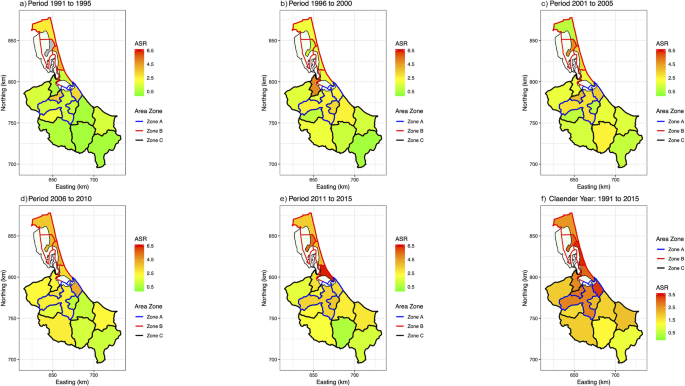The ASR of NMSC of the head, neck, and face in Songkhla Province was 1.00–2.47 per 100,000 persons/year, which is lower than the rates reported in England (98.85 per 100,000 persons/year) and Scotland (118.9 per 100,000 persons/year)1. Additionally, the rate was the lowest for residents of Songkhla Province, which is close to the equator. To the best of our knowledge, the incidence rate of NMSC in women who lived in zone A (city) was decreasing, which may be related to the increased rates of sunblock usage. Meanwhile, the rate of SCC in zone C (rubber plantation) was decreasing. Concurrently, the incidence rate of NMSC in Songkhla remained steady, in contrast to the rising rates reported in Western countries due to sun-seeking behavior, improved cancer registration, and population aging1.
The skin types on the Fitzpatrick scale of the Thai population tend to fall into categories III–V19, which are considered protective against skin cancers. The projected ASR for 2016–2030 was 2.00 per 100,000 persons/year, following a steady pattern in both the Joinpoint and A-P-C models, and showing some decrease in NordPred analysis.
High exposure to UVR is a risk factor for BCC, SCC, and cutaneous melanoma in adults1,2,10,21,22. In addition, UVR exposure is associated with increased risks of pterygium, photokeratitis, cataract, and eyelid malignancies23,24. The present analyses focused on the trend in the incidence of NMSC in the exposure area. Population-based estimates help evaluate disease burden. The region of Songkhla can be divided into three zones: zone A (city), zone B (rice plantation), and zone C (rubber plantation), resulting in different levels of UVR exposure.
The population of the southern region of Thailand is unique in its cultural composition, whereby 30% of people identify as Muslims; for comparison, most of Thailand comprises 95% Buddhists. Additionally, the city of Songkhla includes residents of Chinese origin with skin type III on the Fitzpatrick scale, which is prone to UV radiation-induced erythema and has an increased risk of skin cancer development25. This study revealed no difference in the ASR between Buddhists and Muslims; in contrast, a previous study from Singapore showed higher disease incidence among older Chinese residents than among their Malay counterparts. In Songkhla, the UV index reaches 12–13 in summer. However, the incidence of NMSC appeared relatively constant in this study. Although UVR exposure is much higher in Songkhla, the risk of skin cancer is lower due to melanin protection associated with the residents’ skin type.
UVR exposure, including history of childhood sunburn, increases the risk of cancer development in later life26. Keratocyte-based cancers (BCC and SCC) are primarily caused by the accumulation of DNA damage from UVR exposure and require 40–50 years to develop. Before 1990, all residents of Songkhla were agriculturists. Currently, zone A residents tend to have indoor occupations, and the APC for the disease incidence is − 1.2. In the present study, women in zone A tended to have decreasing rates of NMSC, likely due to sunscreen use. Although zone C populations work outdoors, the working day lasts from 2.00 to 6.00 a.m., resulting in negative APC among men. Zone B population showed some increases in disease incidence that may be related to working on rice plantations, which tends to happen between 9.00 a.m. and 3.00 p.m. when the UV index peaks. Our findings revealed that the duration of UVR exposure and variation of occupations are risk factors for NMSC in the exposure area.
The incidence rate of SCC in zone C decreased significantly (p < 0.001), which may be attributed to the area being covered with rubber trees that provide shade and working pattern at rubber plantations, which tends to be at night (2:00 a.m. to 6:00 a.m.), thereby reducing UVR exposure. These findings suggest that cumulative UV exposure plays a more substantial role in SCC carcinogenesis compared to that of BCC, which involves a more complex set of etiological factors. The leading risk factor for BCC is accumulated UVR exposure, starting from childhood14. Rass et al. reported that UVR-related signature mutations in the p513 tumor suppressor gene are the most common cause of SCC, observed in over 90% of cases. However, UVR-induced mutations are only found in approximately 50% of sporadic BCC cases27.
This study was based on the Songkhla Cancer Registry, which is a population-based registry from 1989 until present, resulting in a relatively low risk of bias. Our dataset covered the entire Songkhla Province28. Our analyses were stratified by sex, histopathology, and occupational zone. The projections of NMSC incidence to 2030 indicated stable trends. These findings are valuable for preparing intensive disease prevention strategies and improving accessibility to public health services.
This study had some limitations. First, patients with small lesions were likely not included in this study, as they are unlikely to be referred for histopathological evaluations, especially if they are being treated in private hospitals. Despite the implementation of universal healthcare coverage in 2002, some patients continue to opt for traditional medicine, decline conventional treatment, or remain under observation, and are, therefore, not included in cancer registries. To the best of our knowledge, this study is the first to explore the incidence, trends, and forward projections of NMSC of the head, neck, and face in Songkhla.
In conclusion, NMSC incidence in these regions remains relatively stable in southern Thailand. However, incidence rates among women living in cities appeared to be decreasing, as did those among rubber plantation workers. The incidence peaks among older adults, suggesting that the number of cases may increase with an aging population.
